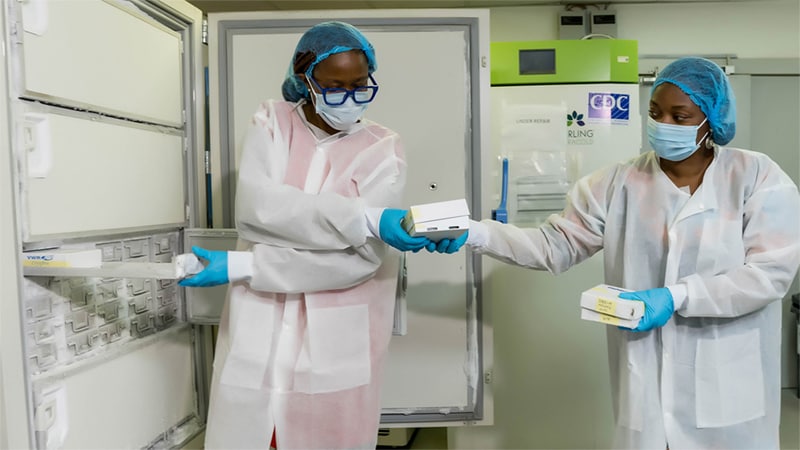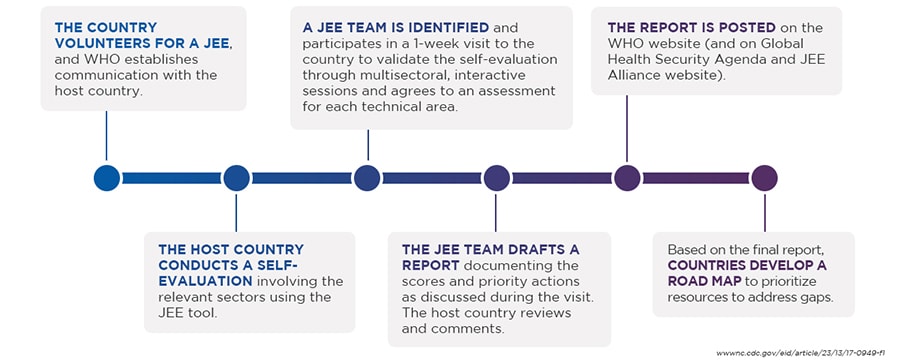At a glance
- International Health Regulations (IHR) are focused on addressing serious public health threats that may spread beyond a country’s borders.
- CDC works with countries around the globe to comply with the IHR.

Overview
The IHR 2005 represents an agreement between 196 countries, and WHO Member States who work on global health security. Under this agreement, all countries must report events of international public health importance.
CDC works with countries around the globe to comply with the IHR 2005. CDC's global programs address more than 400 diseases, health threats, and conditions that are major causes of death, disease, and disability.
IHR requires that all countries have the ability to do the following:
- Detect: Make sure surveillance systems and laboratories can detect potential threats
- Assess: Work together with other countries to make decisions in public health emergencies
- Report: Report specific diseases, plus any potential international public health emergencies, through participation in a network of National Focal Points
- Respond: Respond to public health events
IHR (2005) also includes specific measures countries can take at ports, airports and ground crossings. This limits the spread of health risks to neighboring countries while preventing unwarranted travel and trade restrictions.
Why it matters
A disease can spread from any remote village to any major city on all continents in as little as 36 hours. Recent disease outbreaks, including the COVID-19 pandemic, have demonstrated that a disease threat anywhere is a disease threat everywhere. All countries have a responsibility to one another to build healthcare systems that are strong. They must work to identify and contain public health events before they spread.
Global health security is not just a health issue. A crisis such as COVID-19, mpox, or Ebola can devastate economies and keep countries from developing. The International Monetary Fund estimates that the COVID-19 pandemic will cost the global economy about $13.8 trillion U.S. dollars through 2024. The impact of this kind of economic devastation reaches farther and wider than ever.
With trade and travel expanding on a global level, the opportunity for greater disease spread also increases. The public health and economic impact due to infectious diseases can cause great harm to humans and damage a country's economy.
Notification requirements
IHR (2005) requires countries to detect and report potential events constituting public health emergency of international concern (PHEIC).
Once a WHO member country identifies an event of concern, they must assess the public health risks within 48 hours. If the event is determined to be notifiable, the country must report the information to WHO within 24 hours. Some diseases always require reporting under the IHR, no matter when or where they occur. Others become notifiable when they represent an unusual risk or situation.
Always Notifiable
- Smallpox
- Poliomyelitis due to wild-type poliovirus
- Human influenza caused by a new subtype
- Severe acute respiratory syndrome (SARS)
Other Potentially Notifiable Events
- Cholera
- Pneumonic plague
- Yellow fever
- Viral hemorrhagic fever
- West Nile fever
- Other diseases and biological, radiological or chemical events that meet IHR criteria
Under IHR (2005), a PHEIC is declared by the World Health Organization if the situation meets 2 of these 4 criteria:
- Is the public health impact of the event serious?
- Is the event unusual or unexpected?
- Is there a significant risk of international spread?
- Is there a significant risk of international travel or trade restrictions?
When a PHEIC is declared, WHO helps coordinate an immediate response with both the affected country and other countries worldwide.
Since IHR (2005) was put into place, WHO has declared the following PHEIC:
- Mpox (2022–Present)
- COVID-19 (2020–2023)
- Polio (2014–Present)
- Ebola (2014–2016) & (2019–2020)
- Zika virus (2016)
- H1N1 influenza (2019–2010)
In the United States
CDC works with state and local reporting and response networks to receive information at the federal level. CDC then responds to events of concern at the local and federal levels. The Department of Health and Human Services has the lead role in carrying out the reporting requirements for IHR (2005). The Health and Human Services' Secretary's Operations Center is the National Focal Point responsible for reporting events to WHO. CDC works with other federal agencies to support IHR (2005) implementation.
Health security action plan
CDC supports countries as they develop and strengthen their National Action Plan for Health Security (NAPHS) following a Joint External Evaluation. Through an all-of-government approach, the NAPHS is developed collectively, with input from different government sectors, and support from international partners. Developing the NAPHS helps countries identify activities that align to the 19 JEE Technical Areas and prioritize them for implementation. The resulting plan details the activities necessary to address gaps within a country's health security capacity. These activities are then monitored to determine what is working, what needs to be changed, and what to focus on next.
CDC works with partners to generate a NAPHS that is realistic and actionable by providing expertise across all stages of development. Specifically, CDC works with partners to facilitate:
- Communication, coordination, and collaboration
- Prioritization, resource mapping, and mobilization
- Implementation and monitoring
Evaluation
Being adequately prepared to manage these infectious disease outbreaks is a challenge for many countries. IHR (2005) Monitoring and Evaluation (MEF) provides a roadmap for assessing a country's health security capacity. IHR MEF is composed of four processes:
- States Parties Self-Assessment Annual Reporting (SPAR)
- Joint External Evaluations (JEE)
- After Action Reviews (AAR)
- Simulation Exercises (SimEx)
The SPAR is a mandatory process; the JEE, AAR, and SimEx are voluntary. Together, these provide a comprehensive approach to assessing a country's health security capacity and to developing recommendations for addressing gaps.
When used together, these processes can help governments do several things, including:
- Improving their preparedness against infectious disease threats
- Gaining domestic support for health security work
- Directing partners to the areas where more support is needed
To support IHR MEF activities within countries, CDC is a major contributor to preventing, detecting, and responding to public health risks.
Joint External Evaluation
The Joint External Evaluation (JEE) is a voluntary and comprehensive process to evaluate country capacity across 19 technical areas.
Results of the JEE and other country-based assessments can be used to guide the National Action Plans for Health Security. The NAPHS aims to address gaps in a country's health security capacity through a system that aligns to the JEE's recommendations.
The JEE process brings together experts from around the world to help a country assess its strengths and weaknesses. Multisectoral collaboration, through processes like the JEE, is key to strengthening health systems. This means engaging not just health partners, but other government sectors, such as environmental, agricultural, defense, and finance.
Through the JEE, countries are able to:
- Identify the most critical gaps within their health systems.
- Prioritize opportunities for enhanced preparedness and response.
- Engage with current and prospective partners to target resources.
CDC has collaborated with WHO on developing and refining the JEE process and tools since its inception in 2016. As of April 2022, 115 JEEs have been completed including every country in Africa. Over half of the UN member states that committed to achieving the goals of the IHR 2005. CDC has provided assistance in over 60% of the JEEs conducted throughout the world. CDC helps countries who have completed this process translate JEE findings and recommendations into action.

Assessments: January 2016 - present
After a JEE is completed, the external experts work with their country counterparts to produce a written report. Reports include the scores and all-important priority actions. This report serves as a guide for the country on how to build health security capacity within each technical area. The associated priority actions can feed directly into a National Action Plan for Health Security (NAPHS) and other post-JEE planning processes. JEE results are also published online so that partners can work with countries to address health security gaps.
